What Prime Day 2025 Taught Us — and How to Use It Beyond July
The Biggest Prime Day Yet
Prime Day 2025 wasn’t just longer—it was record-breaking. Over four days (July 8–11), U.S. consumers spent $24.1 billion, a 30.3% increase over 2024, according to Adobe Analytics.
What does that mean for individual brands? Let’s break it down:
- Average household spend: $156.37 (across multiple orders)
- Average order value (AOV): $53.34
This isn’t just a mid-year spike anymore. Prime Day is now one of the highest-intent sales moments of the year, and brands that came in with structured plans reaped the rewards.
Shopper Behavior Shift: Price Sensitivity & Mobile Dominance
If you had any doubts about the shift in shopper priorities, this year’s numbers made it clear:
- 67% of items sold were under $20
- Only 3% exceeded $100
Shoppers were bargain-hunting, and lower-ticket items dominated across apparel, home, and personal care.
Equally important: 53.2% of online purchases happened on mobile. That means if your PDPs weren’t mobile-optimized, you likely lost visibility or conversions. Mobile isn't just a trend—it’s the default.
How 2025 Was Different—and Why It Mattered
With four full days of deals, Prime Day 2025 gave brands more time to show up—but also raised the bar. Here’s what made this year stand out:
More shoppers came late to the party: Sponsored Products saw a surge at the end of the event, with ad-attributed sales jumping +310% YoY on Day 3 and +443% YoY on Day 4. That shift forced brands to rethink how they pace budgets and offers throughout the window.
Ads worked harder—and smarter:
- Sponsored Products delivered stronger performance across the board:
- Spend increased 20%
- Click-through rate rose 81%
- Conversion rate jumped 20%
- CPC dropped 11%
- Amazon DSP followed suit:
- Spend grew 31%
- Impressions climbed 46%
- CPM dropped 10%
New buyers joined later: By Day 3, 70% of shoppers were new-to-brand, showing the value of stretching out your activation strategy. Brands that saved compelling offers for later in the event saw real payoff.
The takeaway? A four-day Prime Day rewards brands that stay nimble—not just those that show up early.
What This Means for Your Q4 Strategy
If you’re planning for Q4—or looking to extend momentum into holiday—Prime Day 2025 offers clear direction:
- Double down on mobile UX: Review how your pages, offers, and carts perform on mobile. Most shoppers won’t see the desktop version.
- Spread your deals intentionally: Prime Day isn’t Day 1-centric anymore. Brands that performed best spread their value across all four days.
- Make your ad budget flexible: Static media plans missed the window. Be ready to pivot spend and messaging in real time.
- Capture and retain new buyers: With 70% of Day 3 buyers being new-to-brand, post-sale flows and retargeting matter more than ever.
- Don’t let momentum fade: Keep traffic warm with follow-up promos, bundles, and campaigns designed for re-engagement.
Planning Ahead: Questions to Ask Before Prime Day 2026
Before Q4 gets overwhelming, use this moment to reflect:
- What was your most profitable day—and why?
- Which audiences converted best?
- Did your creative perform better on mobile or desktop?
- Was your team able to respond dynamically over 4 days?
- Which levers worked—and which didn’t?
These aren’t just campaign questions—they’re business questions. And how you answer them will shape your growth strategy into 2026.
My Take
Prime Day 2025 showed us that shoppers are savvy, timing is critical, and mobile is non-negotiable. But more than that, it proved that brands with structure, clarity, and agility win.
The four-day window rewards precision—not pressure. At HatchEcom, we help brands navigate moments like these by embedding with their teams and driving execution at every level.
We’ve seen firsthand how preparation beats panic. And we’re already thinking ahead.
Let’s do this better together next time.
.png?width=238&height=70&name=Logo%20HatchEcom%20azul%20(1).png)
.png?width=200&height=59&name=Logo%20HatchEcom%20azul%20(1).png)





